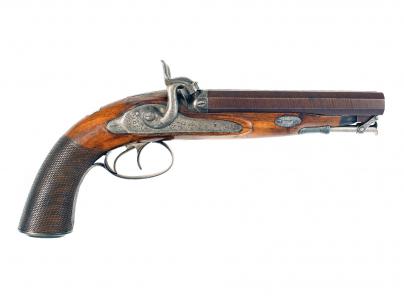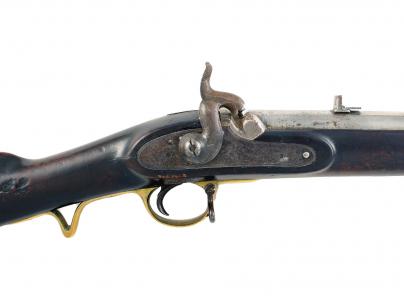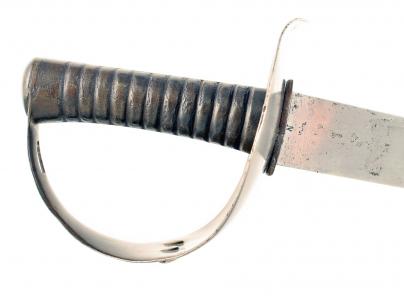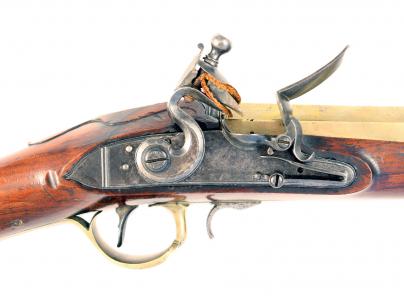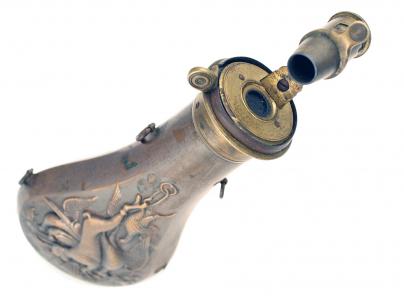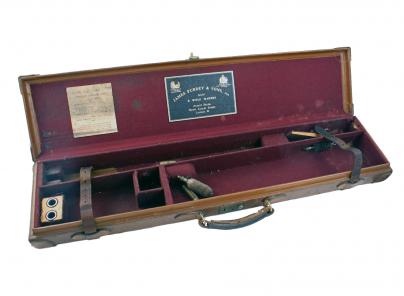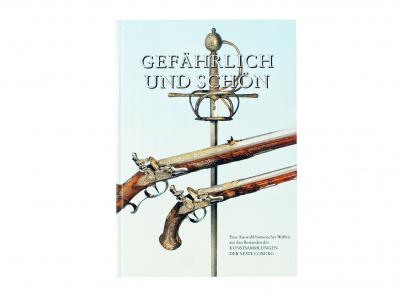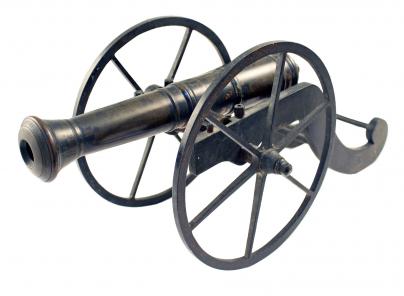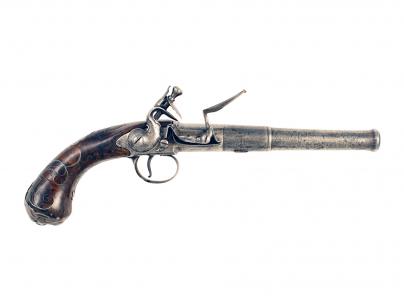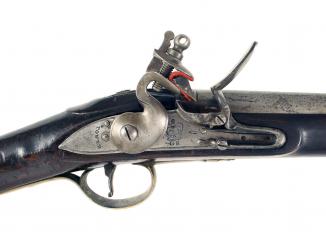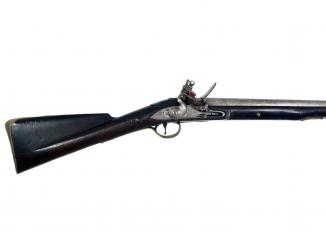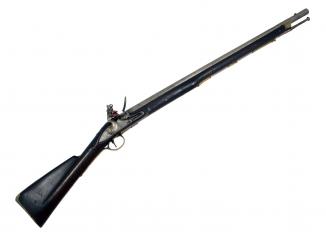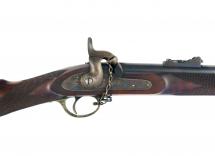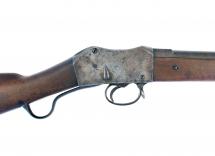An Eliotts Carbine
With plain barrel and tang, the former with fore-sight also forming the lug for a bayonet, border engraved rounded lock with 'GR' crowned and 'Tower' across the tail, figured full stock, with apron around the barrel tang, stamped with inspector's marks behind the trigger-guard tang and with initials 'TG' behind the side-plate, regulation brass mounts, flat side-plate of shaped outline, brass fore-end cap, steel sling bar, original steel ramrod with characteristic swelling cut with a groove, Tower proofs.
Notes:
Scottish-born General George Augustus Eliott was educated at the University of Leiden, where he studied artillery and military theory at the École Militaire in France. Having served in the Prussian Army from 1735-1736, he then took part in the War of Austrian Succession (1740-1748). Later, during the Seven Years War (1754-1763) he served as aide-de-camp to King George II, being appointed Colonel of the 1st Horse and later the 15th Light Dragoons in 1759. In 1765 Eliott was promoted to Lieutenant-General, and eventually in 1778 promoted to the position of General, overseeing many of the improvements to the defences of Gibraltar. For his part in the defence at The Great Siege of Gibraltar in 1782, Eliott was rewarded by the King, and Parliament made him a Knight of the Bath. He died in 1790 whilst returning to Gibraltar.
It is not entirely clear how much input Eliott originally had over the design of the carbine named after him, but evidence does survive that reveals his interest in carbines supplied to the cavalry. Having studied military theory, and with a number of years of actual service under his belt, it seems likely that Eliott did have a good idea of what firearms would be most effective in the hands of the light cavalry.
The introduction of the light cavalry into the British Army stems back to the mid 1750s, with their official introduction taking place in 1759. This experimental period saw a range of carbines being used by the cavalry. A 'Light Dragoon Carbine' introduced by the Clothing Regulations of April 1755 had a 37 in barrel and a 17 in bayonet. Around the same time the Pattern 1756 Cavalry Carbine 'without bayonet for Horse', and the 'Blues' Carbine of 1755, intended for use by the Royal Horse Guards, had carbines more suitable for use by heavy cavalry. It had been recognised that light dragoons were intended to fight from horseback rather than on foot, making the need for a bayonet obsolete, and the sheer length of a 37 in barrelled carbine was not ideal for use on horseback. With the evidence before them, it was clear that the light dragoons also required a more bespoke weapon for the task they were required to fulfil on the battlefield.
The first incarnation of the Eliott Carbine appeared in 1760. It had an overall length of 42.5 in, a barrel length of 28.75 in, a bore diameter of 0.67 in, and weighed between 6 1/2 and 7 lbs. Very early examples are fitted with a 'dog catch' which was discontinued in 1765. After this date, locks which had been previously manufactured were modified with the removal of the catch and the lock filled in. It has a blade style foresight located around three inches from the muzzle and no provision for bayonet.
The wooden ramrod with brass ferule is housed underneath the barrel in the traditional manner, held in place by three ramrod pipes. At the muzzle end the 'composite' pipe, the middle a short-collared pipe and the tail pipe resembling that of the Land Pattern type.
The trigger guard has provision, by way of a stud moulded into the tang of the guard, for the attachment of a rear sling swivel. Some examples are fitted with a 7.125 inch straight sling bar, however certain examples have had the sling bar removed, like the one in the Royal Armouries collection.
Use and Effect
The 1773 and 1799 Elliot Carbines are the most common versions that may be found, and indeed are the type which would have graced the field at Waterloo. These types of Eliott Carbine had a long period of service from 1773-1840. In the 19th century, many of them were cut down, rifled and issued to volunteer regiments. The Eliott Pattern was also copied by gunmakers and used for private sale.
The most obvious change to the 1773 and 1799 carbine was the reintroduction of the socket bayonet. The 17in blade that had featured on the 'Light Dragoon Carbine' of 1755 was reduced to a 13in blade for the 1777 version of the carbine, and later an 11 in blade with a three-stage, three-inch socket for later carbines. Within the collection at the Royal Armouries there is a 1773 Eliott Carbine with a spring bayonet, dating from about 1785, and the bayonet is attached to the right-hand side of the barrel. This reintroduction could perhaps have been for sentry duty or simply because it was better to have the option to mount a bayonet than to not. It attached to the front sight, located 1.5 in from the muzzle.
These types were equipped with an ingenious ramrod fitting. Gone was the wooden ramrod, in favour of the adoption of an iron version. This ramrod had a swell at the muzzle end, which had been cut into a groove or cannelure. Into this groove fits a notch which protrudes from the nose-cap, forming a catch to secure the ramrod. Approved by the king in June 1773 it is often referred to as the carbine with 'the catch to the nose cap.'
As per common practice of the time, a pattern of the 1773 Eliott Carbine was sent to Ireland, where some were made for the 21st Light Dragoons (Royal Foresters). Several of these survive bearing the regiments mark on the barrel and 'DUBLIN CASTLE' on the lock. Modified slightly from Elliot's original 1773 version, an unusual feature of this Irish version is that the barrel is held to the stock by slots and keys (as was common on sporting guns) instead of the normal pin-and-loop method. This version of the carbine has become known as the Royal Forester's Carbine of 1776. Although not uncommon, it is known to be rarer than the Eliott Carbine.
Evidence that Eliott himself was involved in the evolution of this carbine comes from a source dated 1776, where he suggested that the nose-caps should be made from iron instead of brass, perhaps because they were showing signs of wear. Eliott's proposal was turned down on the advice of William King, the Master Furbisher.
The main difference between the 1773 and the 1799 Eliott Carbine is the difference in the lock engraving. The 1799 version adopts the 'India Pattern' lock, which would have been stamped with the relevant markings rather than engraved, the former being a time-saving technique employed during wartime. The 6.5 in straight sling bar is also a common feature on these carbines, however it is possible to find these carbines with the yoke design for the forward fitting. Like the 1760 version of the carbine, they can also be found without bar, with sling swivels instead. A final note on the differences between these two versions is the variation of design in sideplates and butt tangs. No explanation for this has ever been offered and so it is possible that these variations occur due to the choice of contractor, a change of design, or even fashion.
Although initially intended for the 15th Light Dragoons, by the late 18th and early 19th century the Eliott Carbine was in use by most of the light cavalry, along with the later Paget Carbine from 1808. It would certainly have featured on the field at Waterloo.
THE ROYAL ARMOURIES collection.royalarmouries.org [online] https://collections.royalarmouries.org/battle-of-waterloo/arms-and-armour/type/rac-narrative-532.html

